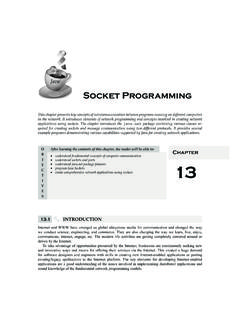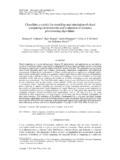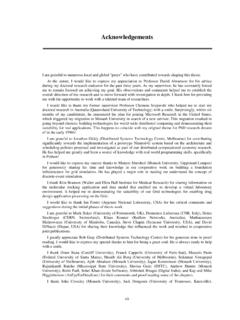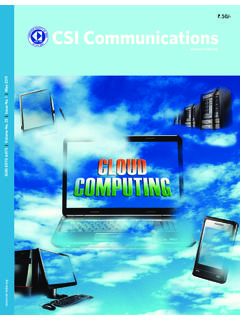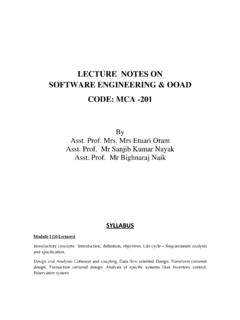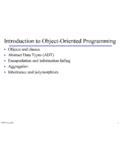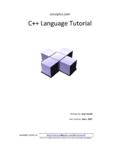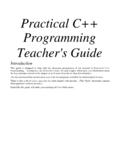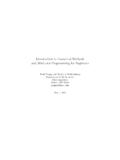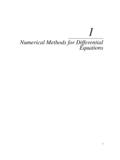Transcription of Java Multithreaded Programming - buyya.com
1 JavaMultithreaded ProgrammingA er learning the contents of this chapter, the reader must be able to : understand the importance of concurrency understand multithreading in java create user-defi ned classes with thread capability write Multithreaded server programs understand the concurrent issues with thread programmingThis chapter presents multithreading, which is one of the core features supported by java . The chapter in-troduces the need for expressing concurrency to support simultaneous operations within java programs, especially those off ering network services.
2 It also introduces multithreading Programming constructs in java including synchronization techniques with examples. OBJECTIVESC hapter14 .1 INTRODUCTIONIn a networked world, it is common practice to share resources among multiple users. Therefore application programs designed to be deployed in a network should be designed to serve multiple users requests simultaneously. Even on desktop computers, users typically run multiple applications and carry out some operations in the background ( , printing) and some in the foreground ( , editing) simultaneously.
3 With the increasing popularity of multicore processors, it is common to see even desktop and laptop computers with an ability to carry out multiple tasks concurrently. To meet these requirements, modern Programming languages and operating systems are designed to support the development of applications containing multiple activities that can be executed operating systems hold more than one activity (program) in memory and the processor can switch among all to execute them. This simultaneous occurrence of several activities on a computer is 14 Multithreaded Programming 365known as multitasking.
4 For example, you can open a fi le using MS Word and you can work on MS Access for creating your database. Two applications, MS Word and MS Access, are available in memory and the processor (by means of the operating system) switches to the application you are actively working on. Here two different applications are made to run concurrently by the same processor. The operating system supports multitasking in a cooperative or preemptive manner. In cooperative multitasking each application is responsible for relinquishing control to the processor to enable it to execute the other application.
5 Earlier versions of operating systems followed cooperative multitasking. Modern operating systems such as Windows 95, Windows 98, Windows NT, and Windows 2000 support preemptive multitasking. In the preemptive type multitasking, the processor is responsible for executing each application in a certain amount of time called a timeslice. The processor then switches to the other applications, giving each its timeslice. The programmer is relieved from the burden of relinquishing control from one application to another.
6 The operating system takes care of it. A single processor computer is shared among multiple applications with preemptive multitasking. Since the processor is switching between the applications at intervals of milliseconds, you feel that all applications run concurrently. Actually, this is not so. To have true multitasking, the applications must be run on a machine with multiple processors. Multitasking results in effective and simultaneous utilization of various system resources such as processors, disks, and printers.
7 As multitasking is managed by operating systems, we encourage readers to refer to books related to that topic. In this chapter, we focus on learning how to write an application containing multiple tasks ( , objects containing operations to be performed) that can be executed concurrently. In java , this is realized by using multithreading . 2 DEFINING THREADSTo understand multithreading, the concepts process and thread must be understood. A process is a program in execution. A process may be divided into a number of independent units known as threads.
8 A thread is a dispatchable unit of work. Threads are light-weight processes within a process . A process is a collection of one or more threads and associated system resources. The difference between a process and a thread is shown in A process may have a number of threads in it. A thread may be assumed as a subset of a A process containing single and multiple threadsIf two applications are run on a computer (MS Word, MS Access), two processes are created. Multitasking of two or more processes is known as process-based multitasking.
9 Multitasking of two or more threads is known as thread-based multitasking. The concept of multithreading in a Programming language refers to thread-based multitasking. Process-based multitasking is totally controlled by the operating system. But thread-based multitasking can be controlled by the programmer to some extent in a Object-Oriented Programming with java The concept of context switching is integral to threading. A hardware timer is used by the processor to determine the end of the timeslice for each thread.
10 The timer signals at the end of the timeslice and in turn the processor saves all information required for the current thread onto a stack. Then the processor moves this information from the stack into a predefi ned data structure called a context structure. When the processor wants to switch back to a previously executing thread, it transfers all the information from the context structure associated with the thread to the stack. This entire procedure is known as context switching.
